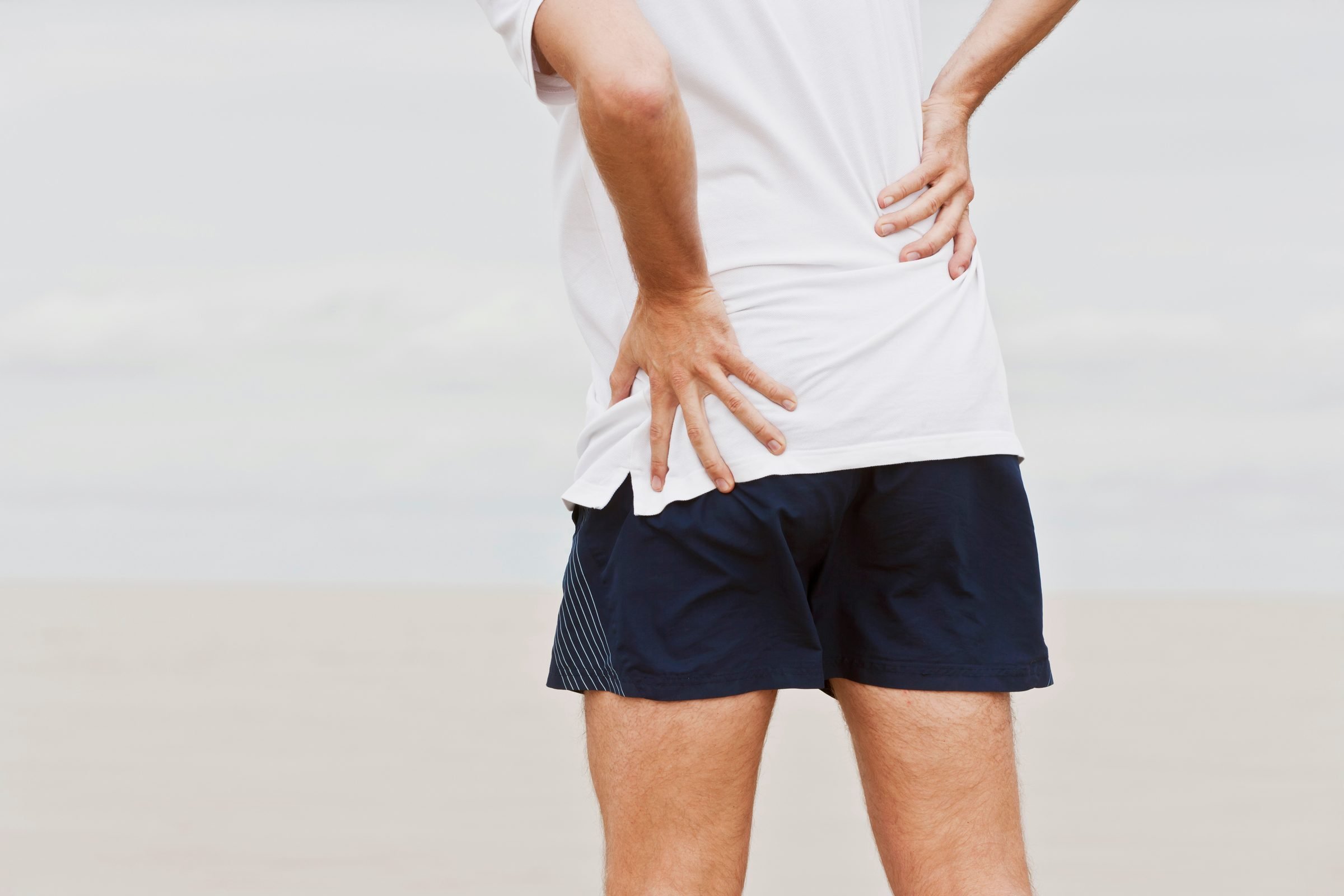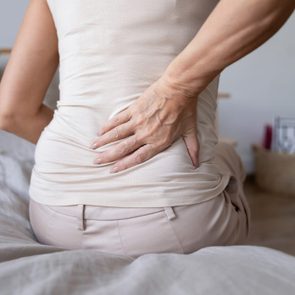What to Know About Radicular Pain, a Common Type of Back Pain
Updated: May 18, 2021
Radicular pain, a nerve issue of the spine, is surprisingly common. Good news: This type of pain usually can be managed with home remedies, physical therapy, and stretching and other exercises instead of surgery.
Understanding lower back pain
Most people will experience lower back pain at some point in their lives, with chronic lower back pain a major source of disability, missed work, and health care expenses. But lower back pain can have a wide variety of causes, with radicular pain, or radiculopathy, accounting for up to 40 percent of it.
How is this unique from other types of back pain? “Lumbar radiculopathy is the result of a pinched nerve in the low back,” says spine surgeon Amit Jain, MD, an associate professor of orthopedic surgery at Johns Hopkins University in Baltimore.
If you’re having lower back pain that radiates down your leg, it could be this type of nerve pain. Read on for more about what it feels like, what causes it, and what you can do about it. Then check out more surprising reasons for back pain.
What is radiculopathy?
Radicular pain can actually occur anywhere along the spine where nerve roots are pinched. “Radiculopathy means ‘radicle’ or ‘root’ pathology [disease], and affects the spinal nerve roots in the cervical, thoracic, lumbar, or sacral spine,” says Andrew Illig, DO, a physical medicine and rehabilitation specialist at Westmed Medical Group in Yonkers, New York.
For a brief anatomy lesson, the cervical spine occurs at the neck, the thoracic in the middle of the back, and the lumbar in the lower back, ending at the sacrum at the base of the spine.
When a pinched nerve happens in the lower back, it’s called lumbar radiculopathy, commonly known as sciatica. About 60 to 90 percent of radiculopathy affects the lumbosacral nerve roots, where the lumbar meets the sacral spine.
What causes radicular pain?
“Any compressive or inflammatory condition that affects the nerve roots before or as they exit the spine can be the cause,” Dr. Illig says.
According to Dr. Jain, this compression of nerves can occur due to a variety of reasons, including spondylosis (spinal arthritis); disc herniations, which occur when the cushiony discs between vertebrae (spinal bones) bulge out of place; and spondylolisthesis (spinal instability), which occurs when the bones themselves move out of place.
“Collectively, these problems result in spinal stenosis, a narrowing of the space available for nerves,” Dr. Jain says. When the nerves get pinched because of this narrowing, it causes pain.
According to the American Academy of Orthopaedic Surgeons (AAOS), 95 percent of people have some degenerative changes to their spine by age 50, due to the general wear-and-tear of aging. “Often in younger patients [the cause of pain] is an intervertebral disc herniation, and in older patients an arthritic or degenerative condition,” Dr. Illig says.
People who are obese or sedentary may be more at risk for these spinal problems as well. Unhealthy habits, like poor posture or wearing high heels, can also contribute.
In addition, certain illnesses can lead to nerve issues in the spine. “Shingles is a viral infection of the nerve root and causes radicular pain,” Dr. Illig says. It is often accompanied by a rash that develops, so if you have skin problems along with your back pain, call your doctor.

What does radicular pain feel like?
“In general, spinal stenosis can present as back pain, radiating leg pain, or cramping or feelings of heaviness in the legs,” Dr. Jain says. “Some people may describe numbness, tingling, or electric pain.” Depending on which vertebra in your lumbar or sacral region is affected, you may experience pain in different areas of your back and leg, from your buttocks all the way down to your calf or foot.
Dr. Illig says the pain may vary in intensity and may be described as burning or pulsating. You might also feel some weakness in the muscles supplied by the affected nerve root.
How can radicular pain affect your life?
Unsurprisingly, this kind of pain can make it hard to get around, which affects the activities of your daily living.
“The pain usually presents with movement and with activity—patients generally report limitations in walking due to pain,” Dr. Jain says. “Some patients require a buggy or require holding on to a cart at the grocery store.”
Being in certain positions may also become more difficult for you. “Sleeping can be difficult,” Dr. Jain says.
Chronic pain and sleep disturbances have been linked to depression, a vicious cycle because depression can make the pain worse as well. To get better shut-eye, “people prefer to bend their knees and put a pillow between their legs during sleep,” Dr. Jain says.
How is radicular pain diagnosed?
Before undergoing any tests, your doctor will examine you. “Radicular pain can be diagnosed by history alone, but a thorough musculoskeletal and neurologic examination can often localize the affected nerve root,” Dr. Illig says. Your reflexes may show differences from side to side, which can help indicate which nerves are affected; in addition, a lack of “sensation to pinprick and decreased muscle strength also indicate specific nerves,” he says.
Most of the time, the diagnosis is based on your medical history and a physical exam, but your doctor may order tests such as X-rays and MRIs to confirm the diagnosis. These tests can’t necessarily pinpoint the cause alone; they “need to be interpreted by the examining physician since spinal abnormalities on imaging are normal and often asymptomatic,” Dr. Illig says. Although this might sound contradictory, it means imaging tests may show other problems besides the one causing you pain.
“Electro-diagnostic testing with electromyography and nerve conduction studies also can be helpful to diagnose radiculopathy,” Dr. Illig says. These tests measure electrical activity in your nerves and muscles, which can help differentiate radicular pain from other issues that may affect the nerve after it leaves the spine.
What at-home, alternative, or lifestyle remedies can help radicular pain?
Thankfully, the AAOS says that 80 to 90 percent of patients with sciatica get better without surgery—and you can do many treatments yourself at home. “Most radiculopathy is treated with rest, ice, and anti-inflammatories,” Dr. Illig says. “Braces to stabilize the affected area can provide relief.” You can try heat packs as well. And although you may only feel like lying around, it’s important to keep yourself moving to reduce inflammation.
(Try these natural back pain remedies.)
Your doctor will likely recommend less-invasive treatments to begin with. “Treatment is a step-wise progression from nonoperative to operative depending on the severity of the stenosis,” Dr. Jain says. “For mild or moderate stenosis, it is generally a good idea to start with physical therapy and/or chiropractic treatment.”
Your physical therapist may recommend stretching exercises; in addition, ask about yoga, Pilates, or other exercise regimens for sciatica pain relief. Acupuncture may also provide some back pain relief.
What medical treatment might be necessary?
If at-home treatments fail to reduce your pain enough, injections may be the next step. “Spinal steroid injections can be a powerful tool to help treat radiculopathy shooting pain,” Dr. Jain says. This is no at-home treatment, though; injections are done by experts with advanced training.
Dr. Illig agrees that corticosteroid injections, guided by fluoroscopy (think of it like an X-ray movie) for persistent moderate to severe pain can provide significant relief. “Epidural cortisone injections are usually performed under local anesthesia in the office, or in surgical centers with sedation by fellowship-trained interventional physiatrists or anesthesiologists,” he says.
In terms of prescription medication, “anticonvulsants such as gabapentin can be very effective in treating severe nerve pain but may have side effects that limit their use depending on the dose and individual,” Dr. Illig says. These drugs may help quell the pain signal from the affected nerve. However, they can cause drowsiness, dizziness, or nausea. And be sure to talk to your doctor about all of the meds you’re taking to prevent any interaction.
What about surgery?
If your pain is severe and persistent or causes a lot of weakness that affects your ability to function, surgery may be an option—provided the source of the pain is clearly defined and can be fixed surgically, says Dr. Illig.
Dr. Jain explains that surgery often involves removing the pressure on the nerves, known as spinal decompression, and sometimes requires an additional step of stabilizing the bones and surrounding structures, known as spinal fusion. “A variety of modern, minimally-invasive spinal surgical techniques can be used to maximize a patient’s benefit and accelerate recovery,” he says.
“The surgery is performed by trained orthopedic spine surgeons and trained neurosurgeons. Both types of physicians are well-equipped to perform surgery for these conditions,” Dr. Jain says. “The key is to pick a surgeon who has completed an advanced ‘spine surgery fellowship’ training.”
Surgical procedures and recovery periods vary depending on the condition, says Dr. Illig.
(These are the secrets your surgeon won’t tell you.)
Is radicular pain ever an emergency?
Occasionally, if it causes sudden and severe problems, radiculopathy can be a back pain emergency. Seek urgent or emergency medical treatment, says Dr. Jain, if you have weakness in the legs or feet; experience problems like foot drop, in which you feel like you can’t walk without your foot “dropping” heavily; or lose bladder or bowel function. Dr. Illig notes that a loss of balance requires an emergency evaluation as well.
Otherwise, if you’re having radicular pain, ask your doctor to refer you to an orthopedic or pain management specialist to help you get the care you need to reduce your symptoms and ease discomfort.



















